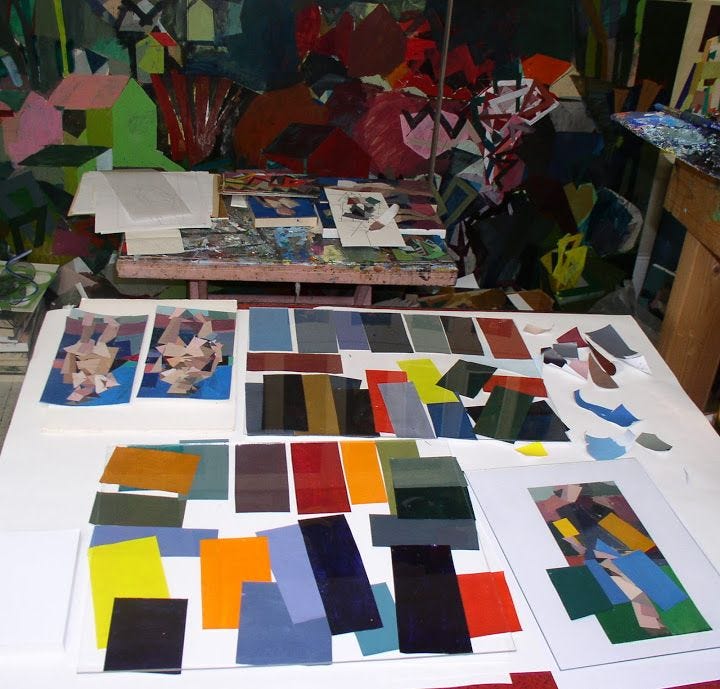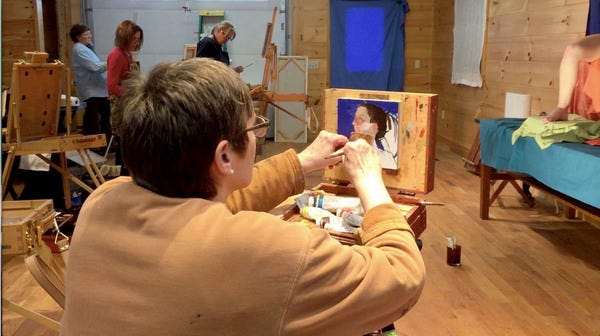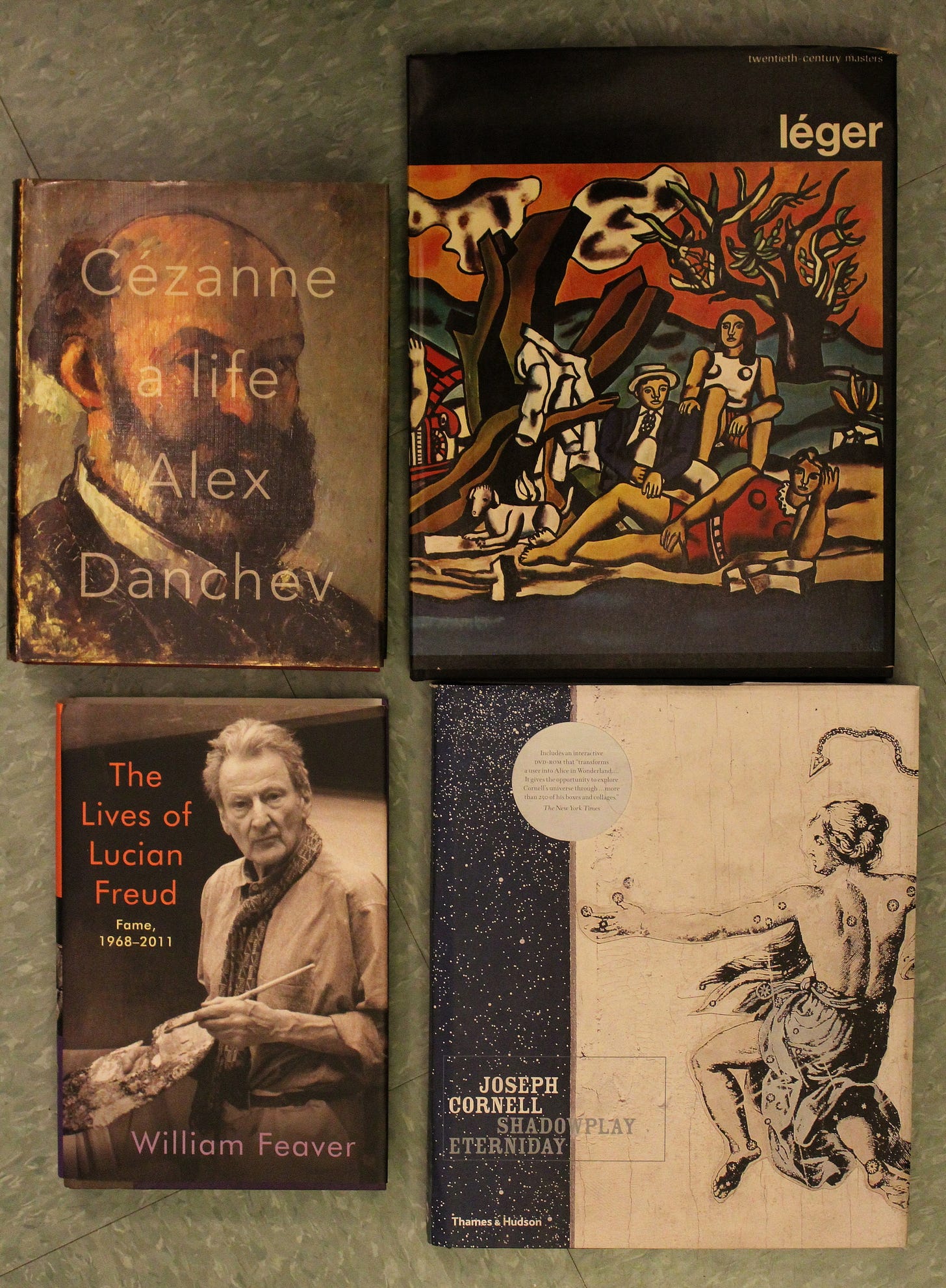(above: a Ken Kewley collage/painting workshop. This is a brilliant artist who seems to effectively relay all the art principles and methods he uses. )
(above: a workshop in session with Catherine Kehoe at Black Pond studio. Great hosts, wonderful instructors, a beautiful setting and great painting facility, and terrific food for lunch if you’re there in person!)
Happy New Year and welcome to 2024, Everyone!
Online education seems to be booming. I see everyone offering art courses online. Mind you , people are offering every kind of course online that you can think of, on every subject. I get a particular kick out of the ones who think of themselves as master salesmen and there are about 5 kinds of bells and whistles in their sales pitches.
And then there are the art videos that promise to teach you very specific things…..How to Paint Like Picasso in 7 Easy Steps…..How to Paint Clouds…….Create Abstract Art that People Want to Buy (WTF???)…….Are You Using your Brushes Wrong? (yeah, I’m using them to give massages to my cat.…she’s on the spectrum and she likes that).
Type some basic, general, painting search words into You Tube and you end up with the most infantile, ridiculous videos. The odd thing is that there are some pretty good video shooting, audio, editing and presentation skills in these videos. People are becoming expert content producers, while often not having a hell of a lot useful to say about the subject area.
Searches in You Tube are great if you want to find out exactly how to change the fuse on your stove, but try to find intelligent, thoughtful, things to say about painting or drawing in general there, and you may be disappointed pretty quickly. There’s a lot of dumbing down of creative endeavor on You Tube, so avoid all that.
There ARE good videos on art there too, but you’re not likely to find them using very general search words. Most likely you’ll have to go to specific artist names, or other more specific reference words.
The people who are genuinely interested in making art, improving their art skills, and growing as artists are, as a demographic, very committed. Email newsletters produced by visual artists often have open rates of 70 - 75%. I think the average email newsletter open rate on all subject areas combined is about 20%…….somewhere in that low range.
In this piece I’ll give you my opinion on the best ways to educate yourself if you want to grow as an artist:
1) If you have money, or are young with parents who can subsidize your education, the best way is still to attend a university or art school that you have researched and are impressed with. This means that you have looked at the faculty and find some people there whose work you appreciate and respect. You have toured the facilities and spoken to students. In my time, university educations were affordable, even for the poor. But things have changed and not for the better over the last 40 years. So the university option may no longer be an option for all those who are interested.
Regular university art class critiques are invaluable if they are structured well. But the kiss of death for a critique is a class full of duds who don’t produce anything of value, or are lazy, or worse, are arrogant, entitled, needlessly argumentative, and quick to be offended. I’ve witnessed some college art critiques that went badly off the rails and it’s not a pretty sight. Luckily, in my experience the bad critiques were the minority. The best critiques are ones where you have a thoughtful, generous, socially adept, highly skilled artist as a professor, who is willing to tell you the full truth as they see it. You need to hear those opinions, and you need to hear a range of those opinions from numerous knowledgeable people.
I don’t know how Woke culture has negatively affected art departments in the last few years, but hopefully art professors still feel that they can speak freely without second-guessing and self-censoring their comments. But sadly, in some places, I have heard the opposite, so if you believe that there is such a thing as quality in art, when you tour your university art department of choice, you should ask some pointed questions of the department head, regarding the issue of free speech for professors and students.
As well, you need students in your class who you respect and whose art capabilities and work ethic match yours, or, are better than yours. Believe it or not, you DON’T want to be the best student in the class. Of course you want to be good, but you need to be watching and seeing how someone more capable than you goes about doing things as well. That is how you will learn. It is a competitive thing, but it is a very generous kind of competition.
The whole studio environment of the art department offers you this enrichment opportunity. You can also see the work of students who are in more senior years than you, all around you. You can interact with those students, as well as with professors whose classes you do not take, but whose work you’ve seen. You can also see how professors interact with other professors and what respect is given or withheld. When you are unsure about any issue, you can ask questions, of a variety of people, in a variety of positions.
Art history is also a large part of your university curriculum, but the way art history is taught in art history departments is not really what you want or need as a maker. So while it’s just fine taking university art history courses, recognize that an artist’s approach to art history is slightly different.
You want to investigate as many artists of all periods as possible, hundreds, and burrow into their lives. These are your real teachers. From them you’ll develop your approach to subject, technique, method, and overall philosophy. You’ll also want to know about their biographies…the life stories and character of these people has a direct bearing on their motivation and what they accomplished. From them you will gradually develop yourself as an artist. And their challenges and trials will help you with yours.
And do not seek to be anyone’s protege. You will become your own person through a grand mixture of what you find exemplary in many others, and your own explorations. But you need to know about and be inspired by these greats that came before you, and by the accomplishments of contemporaries that you are impressed with as well.
Above is just a random sampling of art books from my library. Biographies are as important as the books with numerous color plates of work.
Various contemporary artists discuss their reactions to the work of Marsden Hartley
The link above is an example of a way to study painters that is extremely helpful to artists. It involves looking both at biography, and closely analyzing and deconstructing works from the artist’s oeuvre.
2) Whether you go to university or learn it all on your own, you have to have continual access to this inspiring and teaching history. I think you should dig into this history daily. If you have easy access to a hard copy library, either a civic or university library, haunt the art stacks. Search out new artists always. Buy art books if you have the budget and space for them. Don’t overthink your selections. Simply move towards what attracts you for whatever reason. Ideas and personalities are always in conflict with each other. Don’t worry about white-washing your choices….simply investigate EVERYTHING of interest to you. It is perfectly possible to be influenced by 2 ideas or 2 personalities which seem antithetical, and in deadly conflict with each other. Do not edit or veto your preferences (for Woke concerns or any other), especially in the early stages of encounter.
Online sources are also great, but be careful that you don’t restrict yourself to only a few favorites. Try to be always searching for new people, especially when looking at contemporary art. I mentioned earlier the problem sometimes with searching for visual art content online, but you’ll develop search strategies that will work. Search for and find art videos that appeal to you.
Below is a good example of a contemporary artist video worth watching. But it’s up to you to find the people that are the most inspiring for you. There is a mountain of material to search through, but make the search itself enjoyable.
Contemporary artist Dana Schutz
3) It’s not your aim to simply become a skillful artist. I know this sounds odd, and perhaps even wrong. But this is too narrow an aim! You WILL gain skills as you continue your studies, and you WILL become capable as a result of interest and application. Becoming skillful is a natural product of your involvement. Rather, move towards some larger desire. The desire to be admired simply for your skill is just silly and not a worthy goal, or worse, it will keep you locked into a narrow stylistic path that corresponds to what you have already been praised for. This doesn’t mean that you won’t aim to specifically gain skills and techniques at different stages of your learning..…of course you will. Just recognize that the aim is much larger than just to appear skillful at something.
4) Online art courses and in-person art workshops are a great way to expand your art horizons, improve skills, and exchange ideas, successes, frustrations, and stories with like-minded peers. Although developing as an artist is a relatively isolated pursuit, through courses, you can to some degree mitigate the degree of isolation. Choose carefully based on your response to the instructor’s work, and if the experience is a positive one, take many courses, and collect all sorts of opinions about good ways to proceed with your art learning.
5) Spend lots of time pouring over artist’s web pages, looking at images. You can self-teach this way by deconstructing the work and asking yourself many questions. Populating your Facebook, Instagram, and Pinterest pages with countless artists whose work you enjoy will also give you an automatic, continual daily feed of work that inspires you.
Here are a few good sources for online art courses, as well as art courses that you can travel to in person:
I produce new works daily and they are immediately added to my sites:
Notes on Painting, Lecture Recording with Harry Stooshinoff








Thanks for sharing the Marsden Hartley video. I really enjoyed it. I have always loved Hartley's landscapes.
Thank you. This was so timely for me!